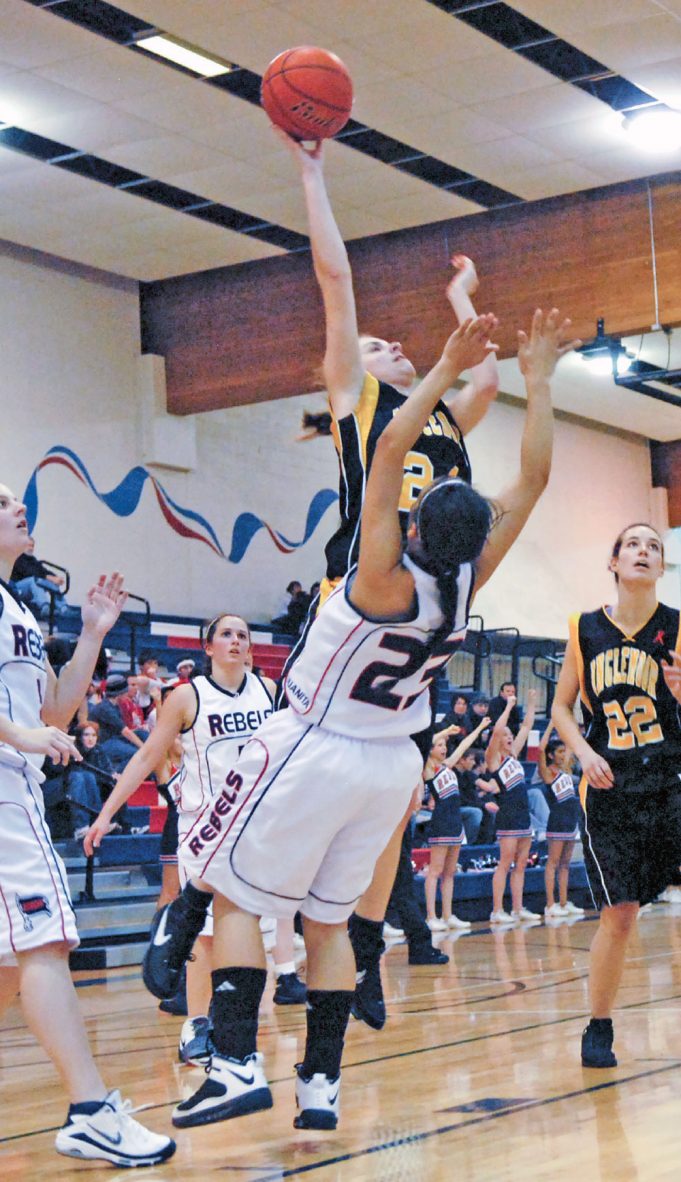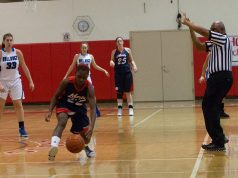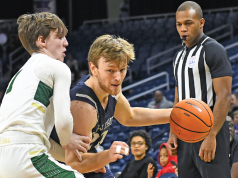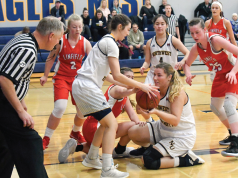Does anybody remember the old days when basketball was a non-contact sport and most fouls were easily identified and called? I can hear you seasoned officials chuckle and see you rolling your eyes and nodding your heads.
Now, we have some plays that have no simple, easy solutions. Plays like the dreaded blarge.
In more than 20 years of basketball officiating, attending meetings, clinics, and both high school and college camps, I have heard about the dreaded blarge many times. Not once has the instruction been associated with how to officiate it, but only to avoid it at all costs. I’ve heard officials say, “That will never happen on my court!” And while we would like that to be true, it has happened to the best of the best. And when it happens on my court, will I be prepared to call it by rule?
I admit it has happened on my court. More than once. I’ll never forget the first time it happened. It was in the days of the two-person crew in one of my early years of high school officiating. I was in the trail position when a rapidly moving, driving player went up for a shot and contact occurred. The play intersected our primary area where either of us could make the call, and it was clearly a play where a call had to be made. This was one I wanted to sell and I constructed a ferocious player-control foul. (Using all the right mechanics, of course.)
At the same time, my partner came with determination from the lead position, equally selling the block call. I looked at him. He looked at me. Our eyes widened. We simultaneously pointed at each other and said, “You take it!” Realizing that whomever took the call to the table was going to be questioned, to say the least, we discussed what to do. I ended up reporting to the table.
You won’t find the word blarge in the rulebook or casebook unless, like me, you’ve penciled it in yourself. You can find it on YouTube if you put in a search for it, where you’ll get videos of even college and professional games where the officials cannot agree on the correct call. Do we go to the possession arrow as TV game announcers have said should happen when officials do not agree?
Not many years ago, the infamous blarge also took place in a high-stakes high school state championship game in Michigan. The officials came together but neither was willing to give up the call and a visible argument ensued. Is it a block? A charge? Do they negate each other? Does the basket count? Who gets the ball?
If there is any call an official would like to avoid having to make, clearly the blarge is that call.
When it comes to adjudicating the blarge, several factors may come into play. The first is probably simple human resistance to having it happen on your court at all. No one wants to deal with the complex explanations with coaches or at the table. The second may simply be that in a noisy gym, the second whistle is hard to hear. But I suspect the most common reason is that sometimes we are just not sufficiently prepared ahead of time to actually call it by rule. Not surprising, since it isn’t in the rulebook at all by the term “blarge.” But with a bit of digging in the casebook, help can be found.
Although the blarge is not listed in the correctable error section, we can find it in the NFHS casebook under double fouls at 4.19.8c.
A1 drives for a try and jumps and releases the ball. Contact occurs between A1 and B1 after the release and before airborne shooter A1 returns one foot to the floor. One official rules a blocking foul on B1 and the other official rules a charging foul on A1. Even though airborne shooter A1 committed a charging foul it is not a player-control foul because two fouls result in a double personal foul.
First, both players are penalized, each being charged with a personal foul — one a blocking foul, the other a charging foul. If the try is successful, the basket counts and the ball is put in play at the point of interruption, which is a made basket, and team B will inbound the ball for a throw-in from anywhere along the endline. If the try is missed, the point of interruption is a try in flight, so the alternating-possession procedure is used and a designated-spot throw-in awarded. The wording of this caseplay does not indicate either official is wrong, but rather that they are both right.
Lest we think this type of ruling is reserved for those working at the high school level, fear not — this same type of play is also quite capable of happening with a college officiating crew, and is therefore also addressed in the NCAA men’s and women’s basketball casebooks.
A.R. 171 in the NCAAM casebook discusses how to adjudicate a double personal foul committed by A1 and B1 when the contact occurs during a try. It is adjudicated in an identical manner to the NFHS ruling depending on whether or not the try is successful. Should the contact occur after a pass in flight instead of during a try — the oft-cited pass-and-crash play — both players are still penalized with a personal foul, and the ball is awarded to team A, the team in control, for a designated-spot throw-in.
The blarge play is handled much differently in NCAA women’s play, as spelled out in A.R. 182. When two officials have conflicting calls, the officials “shall get together and agree to give the call to the official who had the play originate in their primary coverage area. When the officials disagree that the fouls occurred simultaneously, they shall determine which foul occurred first. Once a decision is reached, that foul is reported to the official scorer and the appropriate penalty is assessed.”
It is reasonable to imagine that two officials looking at the same play could make different calls, even if they could be looking from the same angle. What triggers one official’s whistle may not quite trigger the whistle of another. Though we strive to be on the same page as to how much contact should be allowed in a game, we are never seeing plays from the same angle. Even in today’s three-person mechanics, officials can occasionally be looking on-ball at the same time, presenting the real possibility of two officials seeing the same play differently. So eventually the blarge will happen on your court.
And while we might continue to do all we can to avoid it, let’s do so by having a patient whistle, noticing the second whistle and withholding ruling until the calling officials come together to discuss the best way to handle the play. Let’s also know how to properly make the call according to the casebook. Just remember 4.19.8c and we’ll get it right.
What's Your Call? Leave a Comment:
Note: This article is archival in nature. Rules, interpretations, mechanics, philosophies and other information may or may not be correct for the current year.
This article is the copyright of ©Referee Enterprises, Inc., and may not be republished in whole or in part online, in print or in any capacity without expressed written permission from Referee. The article is made available for educational use by individuals.



















